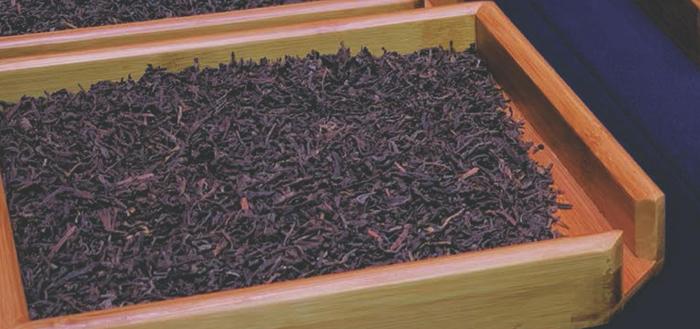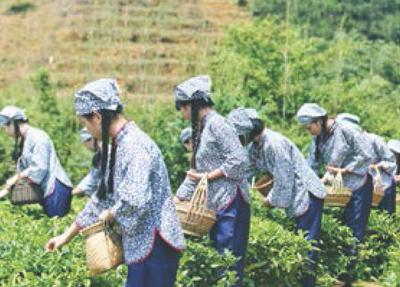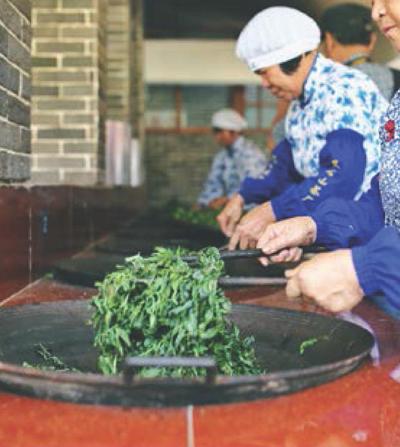To Nurture Your Soul With a Cup of Liu Pao Tea
Mo Tingting



In China, tea is more than a beverage. If you're a tea lover and just want to buy some top-grade, authentic and even rare Chinese tea, please come to Wuzhou, Guangxi! Situated at the subtropical monsoon climatic zone, Wuzhou is an important base for Liu Pao Tea. In this land, vast stretches of mountainous areas are in front of you. Here, a cup of Liu Pao Tea will wake you up, offering you a wonderful lingering flavor.
A remarkable tea for tea enthusiasts
With a history of about 1,500 years, Liu Pao Tea is a kind of post-fermented black tea. It is fermented longer than oolong. The quality of Liu Pao Tea is extremely known for its unique characteristics. Its color is slightly dark-brown and bright. It is aromatic, with a flavor of pine nut. Its taste is refreshing and mellow, which can last all night. The fake Liu Pao Tea is turbid, green with yellow, and tastes “throat-locking”. The dry false Liu Pao Tea is grey, without the feeling of softness, and there is green or green-yellow at the back of the leaf. But the dry real Liu Pao Tea is red-brown or brown. There will be a natural layer of grey “frost” and the tea will be loose.
As an outstanding fermented tea, Liu Pao Tea is mainly produced in Liupu Town, Cangwu County, Wuzhou City, Guangxi Zhuang Autonomous Region. Areas suitable for tea growing are usually in the mountains or canyons, with vertical and horizontal streams, fewer hours of sunlight, year-round mist, and fertile soil.
Liu Pao Tea was listed as one of the famous tea during the region of Emperor Jiaqing (1760-1820). Besides, it is popular in Malaysia. During the tin-mining boom of the 19th century till the late 20th century, British Malaya (todays Malaysia) was a bustling frontier colony populated by a mass exodus of migrant Chinese coolies who came to work in the open tin mines under the harsh tropical heat. To survive the day-in-day-out harsh climate in the open mines, Chinese workers consumed a lot of Liu Pao Tea because of its medicinal effects. As a matter of survival, it was therefore customary that their employers guaranteed a free flow supply of black tea when hiring. Hence, large quantities of Liu Pao Tea were imported to Malaya.
Liu Pao Tea can be saved for a long time and the longer the better. It was in the 1990s that tea enthusiasts accidentally discovered that some old Liu Pao Tea that was stored long past their sell-by dates was still drinkable and even improved with age. Today, aged Liu Pao Tea from the 1950s up to the 1990s are sought after as rare items by tea collectors. Every gram of premium Liu Pao Tea is a historical relic.
Brewing a perfect pot of tea
The traditional production method is a lengthy and delicate procedure. The main steps of Liu Pao Tea are de-enzyming, twisting, moisten heaping and heat energy dehydration. The raw tea leaves harvested in the tea garden should be piled up, and exposed to a high degree of humidity for a certain period of time until the desired level of fermentation is achieved. Water is sprayed occasionally to keep the environment constantly humid and the pile is covered by blankets. Such a humid and warm temperature condition controlled humanly will accelerate the fermentation of the tea, which is known as
“moisten heaping”. Another step is the steaming followed by a controlled wet fermentation process under which the leaves are fully oxidized. The blackened loose tea leaves while still moist are then packed into breathable weaved baskets of typically 30-50 kilos. These huge baskets are stored in a series of dark and damp chambers for up to several years in preparation for consumption. The finished products of Liu Pao Tea have various package styles such as wicker basket packing of different specifications. In Guangxi, the package of Liu Pao Tea is very interesting, such as bamboo basket, cloth basket and so on.
It is ideal to use the dark-red enameled teapot to make a cup of Liu Pao Tea. Serving Liu Pao Tea with boiling water of about 95~100 degrees is recommended. The quantity of tea to be placed for brewing should be decided by the size of the teapot used. You can pour boiling water into the teapot and brew for three to five minutes, then the tea is ready for a taste. Before brewing, it is recommended to wash the tea with boiling water for two times. You should gradually increase steeping time for subsequent brewing.
Commonly found in Chinese restaurants, Liu Pao Tea is an excellent accompaniment to oily food. Liu Pao Tea belongs to the warm-natured tea. Other than health benefits common to other teas, it is more distinct in the effects of clearing heat and eliminating dampness, brightening eyes and clearing away heart-fire and assisting digestion. It can be drunk after meals to assist digestion or before meals to clear intestines. As scientific tests have shown, other than amino acids, vitamins and trace elements needed by the human body, Liu Pao Tea also contains a larger content of lipase than other teas. Therefore, Liu Pao Tea boasts a stronger effect of losing weight, lowering blood pressure and preventing arteriosclerosis. Frequent drinking of Liu Pao Tea can strengthen the stomach, nurture the soul and relieve fatigue.
TIPs
Storage:
The best preserving method of Liu Pao Tea is to package with traditional baskets and storage in a cool warehouse. In addition, the newly-bought Liu Pao Tea has the odor of the warehouse. You can lay them in the air and store them after the odor is over.

